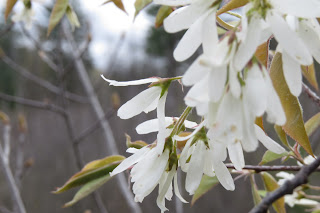Quite different than Tennessee here, isn't it? A month later, Tennessee was way warmer than Ottawa and surroundings. You will see Jan's jacket in the last episode. She has it around her waist. Today, she has it on.
Some ephemerals were making an appearance. We walked along the Crazy Horse Trail (to be reprised in 2018) until flooding turned us back. We did see a few flowers:
This one, above and below is common and easily overlooked, as the yellow-green flowers fail to impress.Later the round light blue fruit will appear. This is Blue Cohosh (Caulophyllum thalictroides).
They look very enticing. From the GoBotany website (New England) we learn:
"Blue cohosh is an attractive wildflower, with an unusual display of the spherical blue fruits held stiffly above the leaf canopy. The roots were widely used my Native Americans as an herbal medicine to treat a range of ailments and as a general tonic."
From the Government of Canada's Biodiversity Information Facility (who comes up with these names??):
"The plant contains chemicals that can cause cell damage. Experiments show that handling powdered root can cause irritation of mucous membranes, with possible dermatitis. No case histories of poisoning were found in the literature, but the plant has poisoning potential. Children should not be allowed to eat the attractive blue fruits of this plant (Muenscher 1975, Lampe and McCann 1985). No references were found of poisoning of livestock."
Another "just-about-to-flower-plant-which=would=look=way=better-if-it-was-flowering-and-which-I-almost-overlooked-because-looking-down-the-leaves-appeared-to-be-more-maplish" is an uncommon plant: Two-leafed Toothwort, Cardamine diphylla. It appears to become more common in the southern deciduous forests, but it isn't commonly found west of Ottawa, where the tend is toward more acid soils.
One of my goals is to be able to identify wild trees and shrubs, especially the more difficult ones. There are 9 Serviceberry species (Saskatoons out west)in our area, and this is one of the more spectacular ones. Pictured above and below, you will see the fuzziness on the new leaves/flower stocks and the clusters of 5 petaled white flowers. The fuzziness distinguishes this plant during Spring: Downy Juneberry or Downy Serviceberry or Shadbush, Amelanchier arborea. Look out at the forest if you are a car passenger this tie of the year, The clusters of large white blooms do stand out, even from far away. The lovely blueberry-like fruit is excellent eating if you can find them before the birds gorge on them.
Speaking of flowers, the above three are Jan (note the coat, as previously mentioned, and her two blooming friends Glenda (pink) and Sandra, who is ignoring the downy Serviceberry over her right shoulder.We had left the flooded Crazy Horse Trail and continued our hike on the March Highlands Trail, where the beaver lodge looked to be actively used. A developer owns this property, and we fear its loss in the not too distant future unless our city comes to its senses.
Development of suburban subdivisions in North America is driven by money driven local politics. It has to stop as it is eating up our wilderness in the Great Lakes region and our farmland. It is also reducing habitat for animals like this Great Egret, Ardea alba (top) which has just started to nest in our area since 2005...Climate Change? And this Ruby-crowned Kinglet, Regulus calendula (it is often you can SEE the ruby colouring)
Next time, a word about the Mississippi Madawaska Land Trust, then on to the summer cottage at end of June, with, maybe, perhaps, possibly, a sighting or two along the way.












No comments:
Post a Comment
Help with "Comments"
1) Click on "Comments" at the end of the blog entry that you wish to comment on.
2) Type your comment in the field provided.
3) Under your comment choose "Name/URL". Type your name (first and/or last names) in the box provided. Choosing "Name/URL" will ensure that you do not need to "register" before leaving a comment.
4) Click "Preview" to see how your comment will look on the site if you wish, otherwise skip to step 5.
5) Click "Publish" to submit your comment.
Please note that all comments are moderated so I will review them before they are published.
I look forward to receiving your comments.